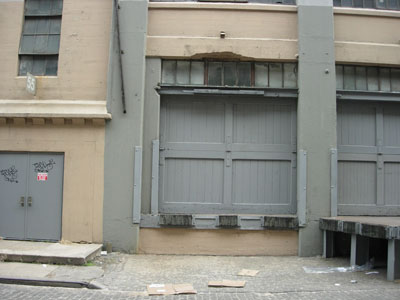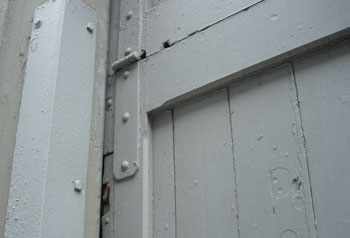 My warehouse complex, Bush Terminal Market, was built in 1907. It's a transitional design, made of poured concrete with wood and cast iron details before the "bauhausing" of architecture streamlined and simplified everything in the 1930's. My warehouse complex, Bush Terminal Market, was built in 1907. It's a transitional design, made of poured concrete with wood and cast iron details before the "bauhausing" of architecture streamlined and simplified everything in the 1930's.
The complex, which is huge (my building is larger than a football field), fell on hard times for most of the past 50 years and in general the only maintenance ever done was the bare minimum. Walls leak, windows are broken, and in general if it didn't break cataclysmically since 1907, or get stolen, it's still there.
Over the years most of the warehouse doors leading out to the loading docks have been covered in ugly painted tin sheets, however a few are original. Their construction represents an example of sturdy, industrial construction that was never meant to be fancy but is. The doors are frame and panel construction. They have to be, the doors are big. Each frame of course has edges that if square would quickly get dinged up in normal use. Not only dinged up but cut and splintered. A fancy molding profile would be out of place in a plain building so the builders used a standard industrial detail. All the frames have stop chamfers on the edge.
 What is a "stop chamfer". A chamfer is a bevel, usually at 45 degrees on the side of a board. It's main purpose is to soften the edge, both visually and more importantly to strengthen the wood corner against dings and donks. Even if you build something with square edges you would want to at least break the edges with sandpaper so that they aren't sharp and don't cut the user or weak so that someone running a finger won't pick up a splinter on a 90 degree edge. When it's "stopped" it means that the chamfer doesn't extended the entire length of the panel. What is a "stop chamfer". A chamfer is a bevel, usually at 45 degrees on the side of a board. It's main purpose is to soften the edge, both visually and more importantly to strengthen the wood corner against dings and donks. Even if you build something with square edges you would want to at least break the edges with sandpaper so that they aren't sharp and don't cut the user or weak so that someone running a finger won't pick up a splinter on a 90 degree edge. When it's "stopped" it means that the chamfer doesn't extended the entire length of the panel.
With a frame and panel, you have have a few choices. You can chamfer the entire length of the board. This extends the chamfer along the rails so that the join between rail and style is accentuated. You see that detail in some modern cabinets. I find it hideous. Another approach is to assemble the frame and panel and run a router with a chamfering bit all round the frame and panel after it's glued up. This gives you a rounded corner which tells everyone you used a router but this approach is pretty common today in factory made furniture.
You would not want to run the chamfer around the frame and panel until after it's glued up because it would be easy to end up with slightly misaligned parts which look horrible. Which of course means that if you want to have square not rounded corners from a router you need to do some chiseling and by hand it's nearly impossible to do the detail after glue-up.
The simple solution is to "stop" chamfering before you get to the corner. this is easily done with hand tools - a chamfer plane and a chisel, or with a router. And most important you can do it before glue-up because you are avoiding touching the joint part of the frame and panel. It's quick and easy and I think it looks very elegant in a sturdy sort of way. And this is why they did it on the doors. It's an easy way to get rid of the sharp edges. If you look closely I think the chamfering was don't by machine on a shaper (the portable router was a later invention).
 But that's not all. The stop chamfer was also used in wooden warehouses on columns. It was a standard way to break the corners so that if bumped into over time they would not splinter and get damaged. I don't have a picture of this but you will see it all the old wooden warehouses. Bush Terminal Market was one of the first concrete warehouses and was built when concrete warehouse design was mimicking the old wooden warehouse. Look at the top of the concrete column - there is a stop chamfer an all the corners. Later warehouses used round columns. But that's not all. The stop chamfer was also used in wooden warehouses on columns. It was a standard way to break the corners so that if bumped into over time they would not splinter and get damaged. I don't have a picture of this but you will see it all the old wooden warehouses. Bush Terminal Market was one of the first concrete warehouses and was built when concrete warehouse design was mimicking the old wooden warehouse. Look at the top of the concrete column - there is a stop chamfer an all the corners. Later warehouses used round columns. |
 Joel's Blog
Joel's Blog Built-It Blog
Built-It Blog Video Roundup
Video Roundup Classes & Events
Classes & Events Work Magazine
Work Magazine






















 My warehouse complex, Bush Terminal Market, was built in 1907. It's a transitional design, made of poured concrete with wood and cast iron details before the "bauhausing" of architecture streamlined and simplified everything in the 1930's.
My warehouse complex, Bush Terminal Market, was built in 1907. It's a transitional design, made of poured concrete with wood and cast iron details before the "bauhausing" of architecture streamlined and simplified everything in the 1930's.  What is a "stop chamfer". A chamfer is a bevel, usually at 45 degrees on the side of a board. It's main purpose is to soften the edge, both visually and more importantly to strengthen the wood corner against dings and donks. Even if you build something with square edges you would want to at least break the edges with sandpaper so that they aren't sharp and don't cut the user or weak so that someone running a finger won't pick up a splinter on a 90 degree edge. When it's "stopped" it means that the chamfer doesn't extended the entire length of the panel.
What is a "stop chamfer". A chamfer is a bevel, usually at 45 degrees on the side of a board. It's main purpose is to soften the edge, both visually and more importantly to strengthen the wood corner against dings and donks. Even if you build something with square edges you would want to at least break the edges with sandpaper so that they aren't sharp and don't cut the user or weak so that someone running a finger won't pick up a splinter on a 90 degree edge. When it's "stopped" it means that the chamfer doesn't extended the entire length of the panel.  But that's not all. The stop chamfer was also used in wooden warehouses on columns. It was a standard way to break the corners so that if bumped into over time they would not splinter and get damaged. I don't have a picture of this but you will see it all the old wooden warehouses. Bush Terminal Market was one of the first concrete warehouses and was built when concrete warehouse design was mimicking the old wooden warehouse. Look at the top of the concrete column - there is a stop chamfer an all the corners. Later warehouses used round columns.
But that's not all. The stop chamfer was also used in wooden warehouses on columns. It was a standard way to break the corners so that if bumped into over time they would not splinter and get damaged. I don't have a picture of this but you will see it all the old wooden warehouses. Bush Terminal Market was one of the first concrete warehouses and was built when concrete warehouse design was mimicking the old wooden warehouse. Look at the top of the concrete column - there is a stop chamfer an all the corners. Later warehouses used round columns.
As I commented in an earlier blog message I grew up and was raised in Brooklyn and last lived and actually got married in Cobble Hill, Brooklyn, not far from where your current location is. The amazing thing is that I must of passed those outer doors thousands of times and never, ever noticed a stopped chamfer. Of course that was before I knew what a chamfer was but nevertheless, the things a person sees when their eyes are open to new ideas.
I don't get back that way very much any more but you can be sure the next time I do,I will stop and check out those chamfers on those huge doors before coming up to visit your shop and look at the chamfered columns.
Michael